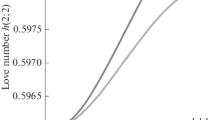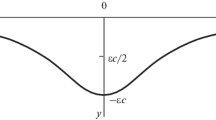Abstract
The relationships between the linearized meteorological variables as expressed in geometric height and in log-pressure coordinates are derived from the assumptions of classical atmospheric tidal theory. While the horizontal velocity components are the same to first-order in the two coordinate systems, a linearized vertical velocity differencew′-H 0ω′ occurs because of the periodic vertical displacement of the constant pressure surfaces due to time-dependent, hydrostatic density perturbations; a linearized temperature differenceT′-τ′ also results when these displacements occur in the presence of a zero-order vertical gradient of temperature. Both of these differences can be expressed in terms of the tidal geopotential field. For a given tidal mode, both differences are generally proportional to the square root of the ratio of the tidal mode's equivalent depth and the atmospheric scale height; the temperature difference is also proportional to the background temperature lapse rate. It is further shown that the two classical tidal vertical structure equations commonly derived in their respective geometric height and log-pressure coordinate systems are in fact identical to first-orderas long as the same thermotidal forcing function is used. Expressions for the zonal-mean components of the tidal bilinear fluxes, formed by zonally averaging the product of two longitudinally varying, linearized tidal fields, are also derived for the two coordinate systems. For the bilinear fields the largest relative differences (a few tens of percent) are for the tidal zonal-mean forcing per unit mass of the zonal wind. For Earth and Mars, differences between the tidal vertical velocity fields are generally less than 25% but may be significantly larger in the Martian atmosphere during one of its episodic planetary-scale dust storms. Tidal temperature differences are generally smaller.
Similar content being viewed by others
References
Andrews, D. G. andMcIntyre, M. E. (1978),Generalized Eliassen-Palm and Charney-Drazin Theorems for Waves on Axisymmetric Mean Flows in Compressible Atmospheres. J. Atmos. Sci.35, 175–185.
Boyd, J. P. (1976),The Noninteraction of Waves with the Zonally Averaged Flow on a Spherical Earth and the Interrelationships of Eddy Fluxes of Heat and Momentum, J. Atmos. Sci.33, 2285–2291.
Chapman, S. andLindzen, R. S. (1970).Atmospheric Tides (Gordon and Breach), 200 p.
Dickinson, R. E. andGeller, M. A. (1968),A Generalization of ‘Tidal Theory with Newtonian Cooling’. J. Atmos. Sci.25, 932–933.
Fels, S. B. (1982),A Parameterization of Scale-Dependent Radiative Damping Rates in the Middle Atmosphere. J. Atmos. Sci.39, 1141–1152.
Forbes, J. M. (1982),Atmospheric Tides 1. Model Description and Results for the Solar Diurnal Component. J. Geophys. Res.87, 5222–5240.
Hmilton, K. P. (1981).Numerical Studies of Wave-Mean flow Interaction in the Stratosphere, Mesosphere and Lower Thermosphere (Ph.D. thesis, Princeton University), 366 p.
Hamilton, K. P. (1982),The Effect of Solar Tides on the General Circulation of the Martian Atmosphere. J. Atmos. Sci.39, 481–485.
Holton, J. R. (1975),The Dynamic Meteorology of the Stratosphere and Mesosphere. Meteorol. Monographs15, No. 37.
Lindzen, R. S. (1967),Thermally Driven Diurnal Tide in the Atmosphere, Quart. J. Roy. Meteor. Soc.93, 18–42.
Lindzen, R. S. (1968),The Application of Classical Atmospheric Tidal Theory. Proc. Roy. Soc.A303, 299–316.
Lindzen, R. S. andMcKenzie, D. J. (1967),Tidal Theory with Newtonian Cooling. Pure Appl. Geophys.66, 90–96.
Longuet-Higgins, M. S. (1968),The Eigenfunctions of Laplace's Tidal Equations over a Sphere, Phil. Trans. Roy. Soc. LondonA262, 511–607.
Miyahara, S. (1984),A Numerical Simulation of the Zonal Mean Circulation of the Middle Atmosphere Including Effects of Solar Driven Tidal Waves and Internal Gravity Waves; Solstice Condition, inDynamics of the Middle Atmosphere (Eds. J. R. Holton and T. Matsuno, D. Reidel Publ. 1984), 271–287.
Zurek, R. W. (1986a),Atmospheric Tidal Forcing of the Zonal-Mean Circulation: The Martian Dusty Atmosphere. J. Atmos. Sci.43, 652–670.
Zurek, R. W. (1986b),Atmospheric Tidal Forcing of the Zonal-Mean Circulation: Earth's Middle Atmosphere. Submitted to J. Atmos. Sci.
Zurek, R. W. (1986c),The Form of Newtonian Cooling in Atmospheric Tidal Theory. Pure Appl. Geophys., this tissue.
Zurek, R. W. andLeovy, C. B. (1981),Thermal Tides in the Dusty Martian Atmosphere: A Verification of Theory. Science213, 437–439.
Author information
Authors and Affiliations
Rights and permissions
About this article
Cite this article
Zurek, R.W. The relations between the linear and bilinear atmospheric tidal fields in geometric height and in log-pressure coordinates. PAGEOPH 123, 902–920 (1985). https://doi.org/10.1007/BF00876978
Received:
Accepted:
Issue Date:
DOI: https://doi.org/10.1007/BF00876978




